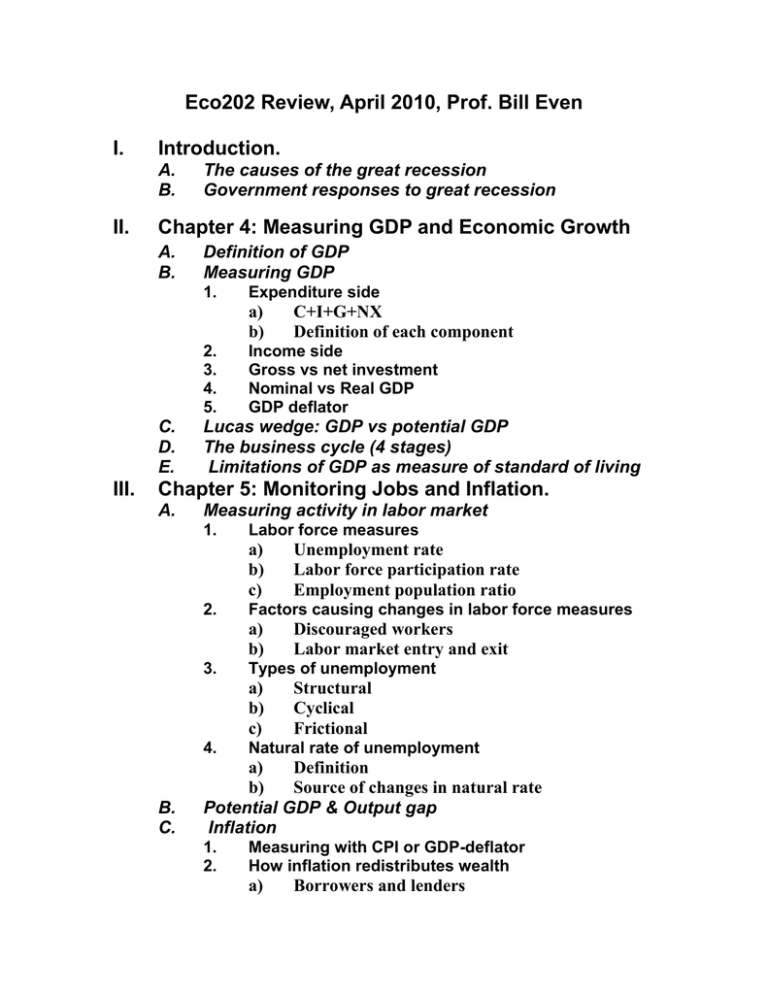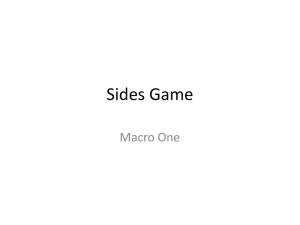Eco202 Review, April 2010, Prof. Bill Even I. Introduction.
advertisement

Eco202 Review, April 2010, Prof. Bill Even I. Introduction. A. B. II. The causes of the great recession Government responses to great recession Chapter 4: Measuring GDP and Economic Growth A. B. Definition of GDP Measuring GDP 1. Expenditure side a) b) 2. 3. 4. 5. C. D. E. III. C+I+G+NX Definition of each component Income side Gross vs net investment Nominal vs Real GDP GDP deflator Lucas wedge: GDP vs potential GDP The business cycle (4 stages) Limitations of GDP as measure of standard of living Chapter 5: Monitoring Jobs and Inflation. A. Measuring activity in labor market 1. Labor force measures a) b) c) 2. Factors causing changes in labor force measures a) b) 3. B. C. Discouraged workers Labor market entry and exit Types of unemployment a) b) c) 4. Unemployment rate Labor force participation rate Employment population ratio Structural Cyclical Frictional Natural rate of unemployment a) Definition b) Source of changes in natural rate Potential GDP & Output gap Inflation 1. 2. Measuring with CPI or GDP-deflator How inflation redistributes wealth a) Borrowers and lenders b) c) 3. Taxes Employers and employees CPI a) b) Construction of CPI Problems with CPI (1) Bias in construction (2) Effect on government spending and tax revenue c) Converting nominal variables into real variables using CPI d) Using CPI to determine value of dollar at different points in time (e.g. $1 in 2000 has same purchasing power as $x in 2010). IV. Ch.6: Economic Growth A. Mathematics of growth rates 1. 2. B. Calculating annualized rate of growth Rule of 70 Sources of economic growth in classical model 1. Labor market a) b) 2. Factors affecting labor supply Factors affecting labor demand Aggregate production function a) Factors shifting production function 3. Using classical model to examine how various factors affect a) b) c) V. Real wages, employment Productivity Potential GDP Chapter 7: Savings and Investment A. B. C. Gross Investment, Net Investment and Depreciation Wealth and Savings Source of funds for investment 1. D. I = S + (T-Tr)-G + (M-X) Loanable funds market 1. 2. 3. Supply of loans (Savings) Demand for loans (Investment) Equilibrium interest rate a) Nominal vs real interest rate 4. Factors shifting supply or demand for loans and effect on interest rates, saving and investment. 5. The role of government budget deficits/surpluses in loanable funds market. E. a) Ricardo-Barro effects. The Global loan market 1. Link between net exports and position as net borrower or lender. a) Net exports>0 net lender b) VI. Net exports<0net borrower Ch 8: Money, the price level, and inflation. A. Money 1. 2. 3. B. C. Gresham’s law Banking 1. 2. 3. D. Bank objectives Trade-off between risk, return and liquidity Fractional reserve banking Structure of Federal Reserve 1. 2. 3. E. Definition Types of money Functions of money Board of governors. FOMC Regional banks. Components of money supply 1. 2. 3. Reserves Monetary Base M1, M2 F. Creation of money by bankings system and deposit multiplier. G. Fed tools and control over money supply. H. Effect of following on money supply, loans and interest rates. 1. Fed open market purchase or sale. 2. Fed changes reserve ratio 3. Fed changes discount rate 4. Public holds more or less wealth as cash outside bank. I. Money supply/demand and interest rates. VII. Financial markets. A. Bonds 1. 2. 3. Present value Relationship between price and yield Calculating yields a) b) One year bond Zero coupon bond 4. Yield curve and expectations about future interest rates. B. Stocks 1. 2. 3. Fundamental value. Price-earnings ratio Beta VIII. Ch. 9: Exchange rate and balance of payments. A. Foreign exchange market 1. Supply of $ 2. Demand for $ 3. Factors changing supply or demand for $ and impact on value of $ 4. Effect of appreciation or depreciation of $ on U.S. exports and imports. B. Interest rate parity 1. Effect of exchange rate movements on net return in foreign assets. 2. Link between interest rate differentials and expected changes in exchange rates. C. Purchasing power parity 1. Opportunities for “arbitrage” 2. Link between inflation differentials and exchange rate movements. D. Balance of payments accounts. 1. Current Account 2. Capital account 3. Official settlements account. 4. Bal of payments and lender/borrower status; debtor creditor status. E. F. NX=(T-G) + (S-I) Exchange rate policies. 1. Fixed exchange rates and intervention required to support under- or over-valued currency. 2. Flexible exchange rates. 3. Crawling peg IX. Ch. 10: Aggregate Supply and Demand. A. Long Run Aggregate Supply 1. The classical model a) b) c) 2. Labor supply Labor demand Production function Determinants of potential GDP and LAS B. Short run aggregate supply 1. 2. Sticky wages As price level rises, movement along LAS causes a) b) c) 3. C. Shifts in SAS Aggregate demand 1. 2. C + I + G + (X-M) Why AD drops when price level rises a) b) c) 3. D. Real wages to fall Employment to rise Real GDP to rise Wealth effect Intertemporal substitution effect International Substitution effect Factors causing changes in AD How economy returns to long run equilibrium 1. Starting from GDP>potential GDP (inflationary gap) 2. Starting from GDP<potential GDP (recessionary gap) X. Ch. 12: Inflation, Unemployment and Business cycles. A. B. Demand pull vs. cost-push inflation. Phillips Curve 1. 2. 3. 4. C. Short run Long run Importance of inflation expectations. Link from AD/AS model to Phillips curve. Business cycle theories. 1. 2. Demand side theories Real business cycle theories a) b) Productivity shocks cause business cycle. Effect of productivity shock (1) (2) real wages, employment interest rates, investment. XI. Ch. 13: Fiscal Policy. A. B. Federal budget process Recent budget issues 1. 2. 3. 4. 5. C. Economic stimulus act Major sources of tax revenue Major spending categories Relationship between deficit and debt Distribution of tax burden Supply side economics 1. Effect of taxes a) b) 2. 3. Distribution of the tax burden and trends. The Laffer Curve. a) b) 4. D. Tax rates and tax revenue Effect of tax rates on tax avoidance. Effect of taxes a) Investment and saving b) Crowding out c) Ricardo-Barro effects on crowding out Fiscal policy 1. 2. 3. E. Labor market Long run aggregate supply Discretionary Automatic stabilizers. Limitations of fiscal policy The budget and the business cycle 1. 2. 3. 4. Actual budget Cyclical budget Structural Budget The effect of business cycle on the budget.





